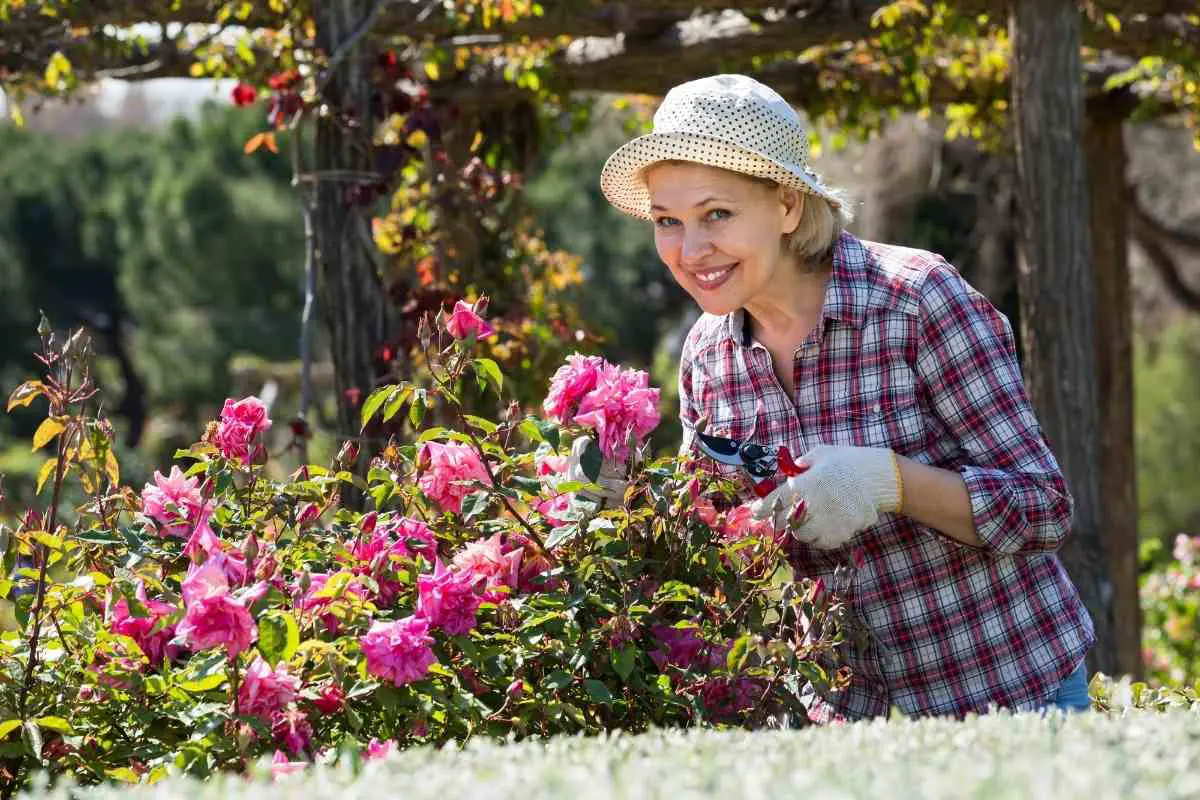The beautiful sight and smell of gorgeous roses are a highlight of the warmer months and an enduring symbol of romance and love.
Roses are a pleasing addition to any garden, their soft velvety blooms being a real accomplishment for any gardener.
Are you wondering when roses are going to bloom in your area? Are your planting roses in your yard?
Read on for our guide to when roses bloom, including a state-by-state, rose bloom calendar and growing tips!
When do roses bloom?
They take their time, but once spring is fully underway, you should start to see roses blooming.
Once their annual growth gets underway in warmer weather, roses take about six to eight weeks to flower with the bush, shrub, or climber-producing rosebuds at different stages of growth for sustained blooming.
For Most Regions – The visual display of roses is at its most striking in June, with the reds, oranges, yellows, and creamy whites of these flowers being closely associated with this month.
The patterns of flowering range from spring and summer flowering to varieties that keep up their blooms straight through to fall.
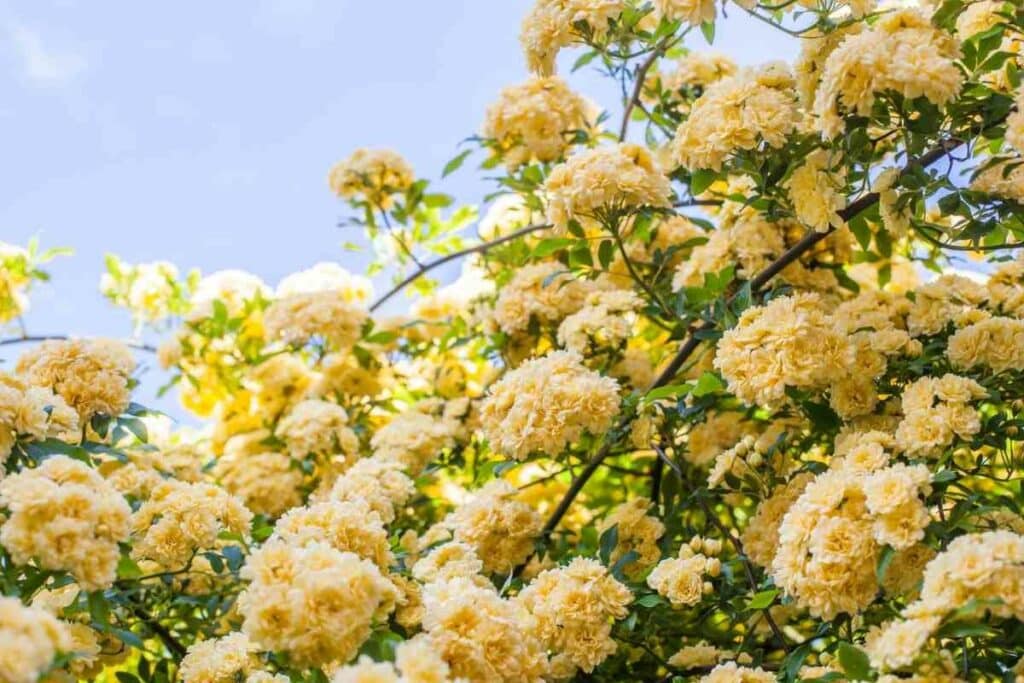
With the right climate and care, some roses can even provide flowers all year round.
Fall usually ends blooming, with roses developing rose hips, that some people harvest for jams and teas.
Key factors that affect blooming
If you are eagerly expecting some beautiful roses this year, make sure that your bushes have the best opportunity to produce large, full, and sustained blooms.
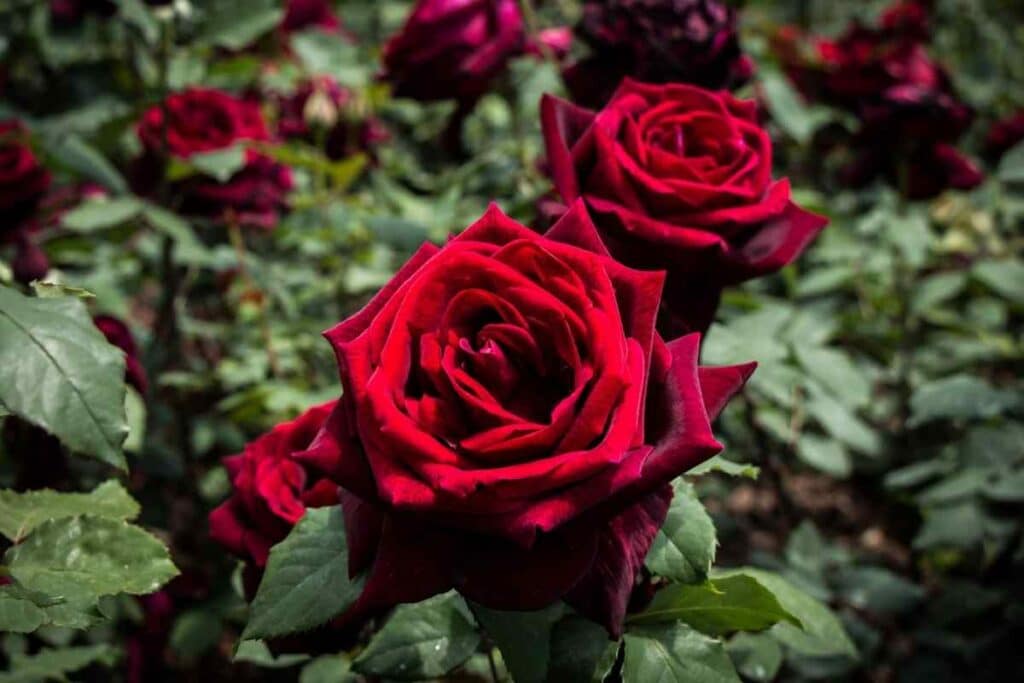
These six factors are key to determining if and when you will get roses:
Location
As we outline below, your location will have a massive impact on when your roses show up.
In the US, roses thrive in USDA plant hardiness zones spanning zone 3 to 11, with plants cultivated in warmer climates blooming sooner than those in more temperate or cold climates.
Use the table below to find out when roses bloom in your state.
Sunlight
Roses need as much sunlight as possible.
At an absolute minimum, five hours per day is acceptable, but ideally, this should be in full sun.
Inadequate sunlight produces “leggy” plants with overly long stems that have had to search for light rather than develop buds.
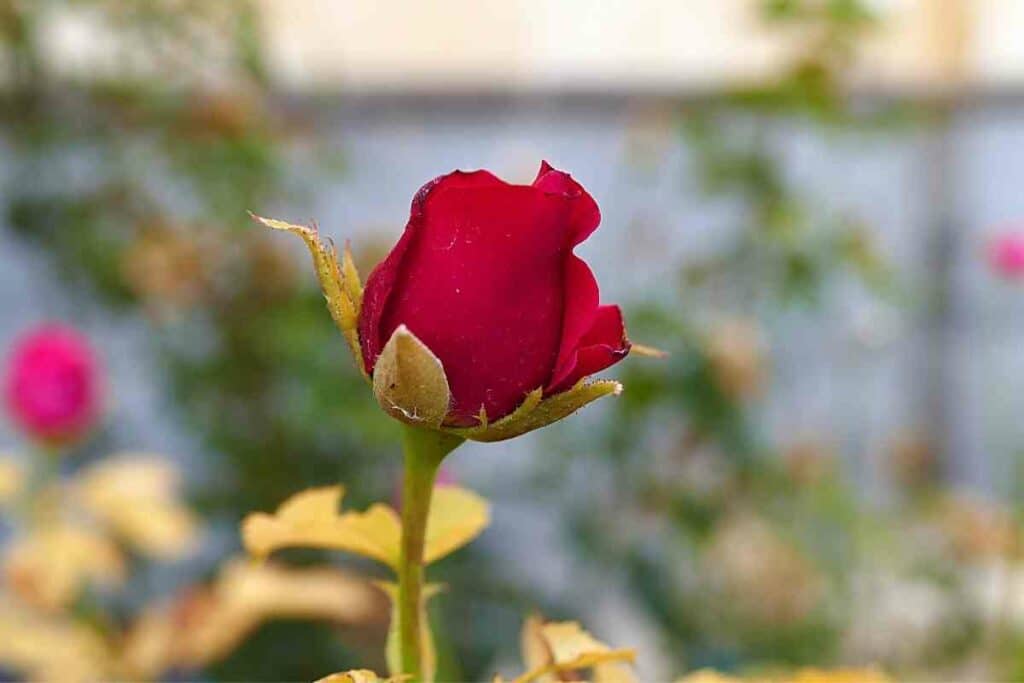
Watering
In the buildup to flowering, water your roses diligently and daily throughout the growing season, with mulching for moisture retention.
This is because they are actively growing in the sun and have greater demand for water and nutrients.
Heads Up! Neglecting to water your roses pre-bloom can inhibit the rosebush from developing buds!
Feeding
Roses are hungry plants and need regular feeding to bring forth their most beautiful blooms.
Don’t hesitate to add a rich compost or a forkful of well-rotted manure when planting them. Regular feeds with a quality NPK fertilizer are the secret to gorgeous roses.
Fish, blood, and bone, and compost tea are potent organic alternatives. Start in the spring and feed every 2 to 3 weeks until the growing season finishes.
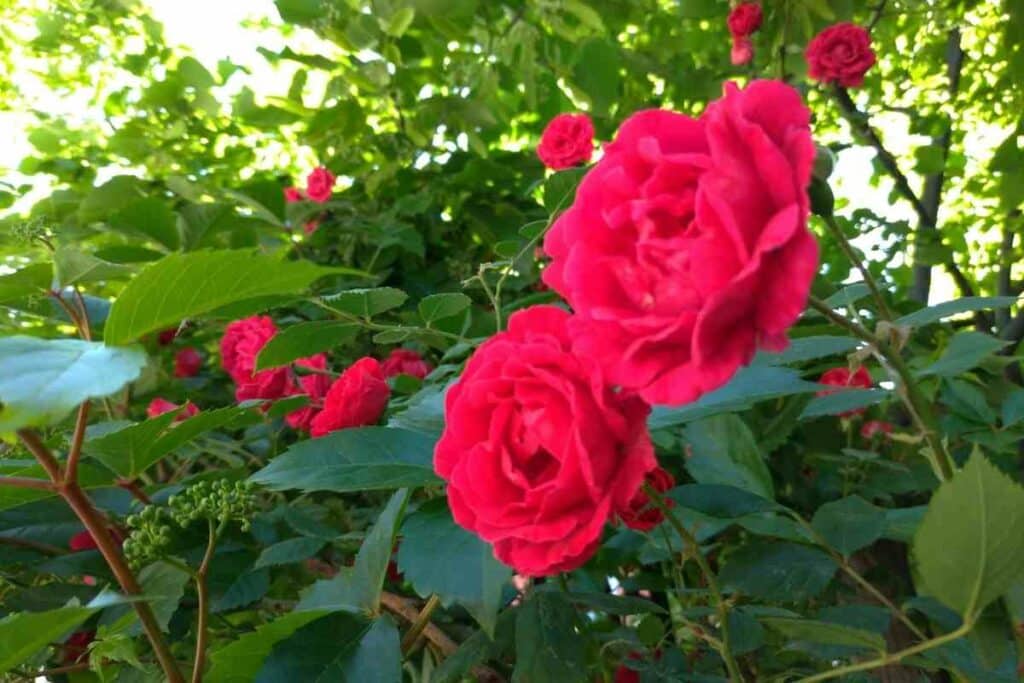
Blind shoots
Blind shoots are a frustrating part of cultivating roses.
These stems develop without any roses at the end of them.
This may be because an unexpected frost kills very young buds, but you can prevent them from developing by ensuring your roses get plenty of sunlight, water, and food.
Weeds and pests
Weeds and sap-sucking pests can drain your roses of their growth and vigor and are a common cause of roses that cannot bloom.
Works Fine – Stay on top of the weeding and spray your roses with garlic juice, and neem oil, or encourage natural predators like ladybirds.
Your location in the U.S. will affect when roses will bloom
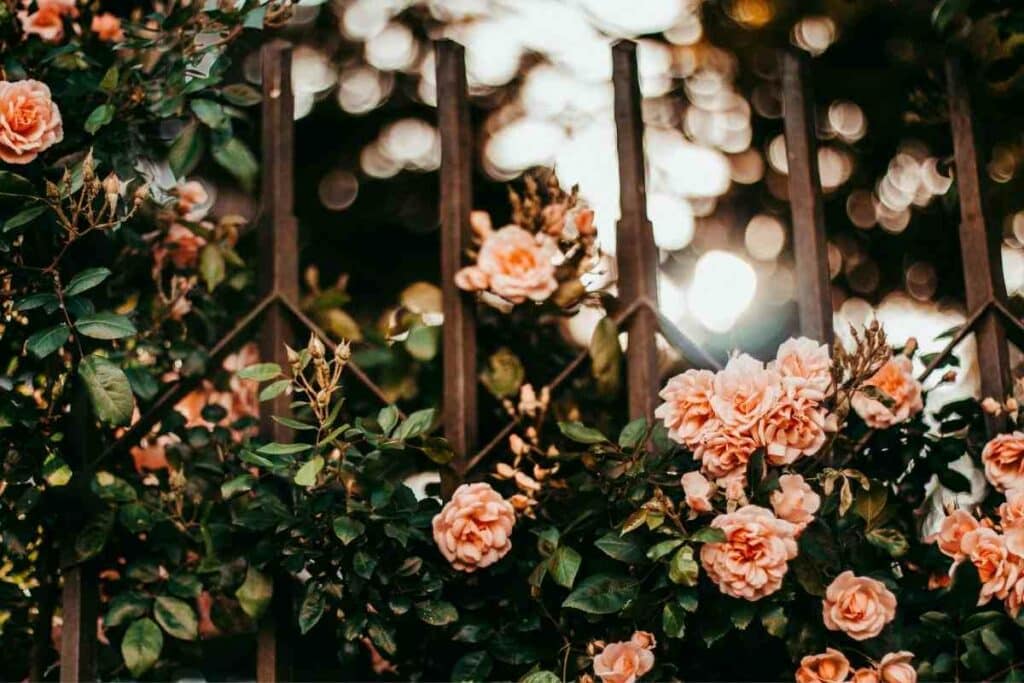
Understandably, your location and growing zone are going to affect when roses are going to bloom.
The warm South is going to see blooming earlier and northern states like Nebraska or Ohio.
Find out when roses will bloom in your state with this helpful chart that includes great local varieties to plant.
| State | USDA plant hardiness zone | Rose blooming time | The best local rose variety |
|---|---|---|---|
| Alabama (AL) | 7b to 8b | Late May | Zephyrine Drouhin – a classic Southern rose variety that thrives in Alabama heat and humidity. |
| Alaska (AK) | 1a to 8b | Mid to late June | Hardy rose varieties like Blanda roses or Scotch roses. Container-grown roses fare best. Bring them in for the winter. |
| Arizona (AZ) | 4b to 10b | Late April | Hybrid tea roses thrive in AZ. Varieties include Chrysler Imperial Hybrid Tea Rose and Double Delight Hybrid Tea Rose |
| Arkansas (AR) | 6 to 8 | May | Belinda’s Dream and Knock Out roses are durable, fast-growing shrubs. |
| California (CA) | 5a to 10b | April and late October | Great SoCal rose varieties include ‘Playboy’ and ‘Playgirl’ Floribunda roses. Shrub rose varieties also thrive in this state. |
| Colorado (CO) | 3 to 7 | Late May/early June | Golden Celebration, Evelyn Jekyll, and Marylin Monroe hybrid teas adapt well to the Colorado climate. |
| Connecticut (CN) | 5 to 7 | Early June | Rugosa roses, China roses, and David Austin roses will do well in the Northeastern states. Cold hardy varieties like ‘Carefree beauty‘ and ‘Quietness‘ will tolerate frosts. |
| Delaware (DE) | 7a to 7b | Late May/early June | David Austin roses are ideal for the mid-Atlantic gardener. Classic tea roses and old varieties will do well in this temperate climate. |
| Florida (FL) | 8 to 11 | Year-round blooming in southern FL – flowering for 9 months of the year in northern FL | The warm and sunny Florida climate brings the best out of tea roses and old garden roses. According to the University of Florida, the best varieties for FL include ‘Mrs. B. R. Cant’, ‘Louis Philippe’ and the more modern Knock Out. |
| Georgia (GA) | 6 to 9 | May and June, some varieties bloom again in the fall. | The Cherokee rose, Rosa laevigata is the Georgia State flower. Lady Banks and the Bourbon rose Zephirine Drouhin are classics. |
| Hawaii (HI) | 11 to 13 | Continual bloom is common | The Honolulu Rose Society cultivates many rose varieties that bloom all year round. Varieties on the island include the Peace rose, Fairhope, and Bolero Rose. |
| Idaho (ID) | 3 to 7 | Mid to late June | ID roses need to withstand the harshest weather. Choose hardy varieties of shrub or miniature roses including April Moon, Hope for Humanity, or Carefree Delight. |
| Illinois (IL) | 6a to 7a | Late May | Shrub roses and David Austin roses are more resilient selections. Hybrid tea roses do not do well. |
| Indiana (IN) | 5b to 6b | June through fall | Shrub roses fare best in the Midwest. Popular Indiana varieties include Knock Out, Earth Song, and Snowcone. |
| Iowa (IA) | 5 | Early June | Knock Out, William Baffin, rugosa roses, Easy Elegance, David Austin roses. |
| Kansas (KS) | 5b to 7a | Mid-May | Shrub roses fare best in the Midwest. Popular Kansas varieties include Good ‘n Plenty, Knock Out, Earth Song, and Snowcone. |
| Kentucky (KT) | 6a to 7a | May to early June | Kentucky weather accommodates a wide range of roses, including hybrid tea roses such as Let Freedom Ring, Olympiad, Denali, Floribundas like Scentimental, and Marmalade Skies, and Grandifloras that include Gold Medal and Octoberfest. |
| Louisiana (LA) | 8 to 9 | April to June and October to early December | LA has one of the longest rose growing in the US. rose to grow is a state tradition and classic Southern varieties like Bourbon roses, China roses, and tea roses make a great display. |
| Maine (ME) | 3 to 6 | June | Cold-hardy varieties are essential. Prune back before winter and protect. You can shelter container-grown roses through the cold months. ‘William Baffin’, ‘Purple Pavement’, Rugosa hybrids. |
| Maryland (MD) | 5b to 8a | Late May to early June | MD has several native rose varieties, including Rosa virginiana (Virginia Rose), Rosa Carolina (Carolina Rose), and Rosa Blanda (Smooth Rose). |
| Massachusetts (MA) | 5a to 7a | June | Rugosa roses, China roses, and David Austin roses will do well in the Northeastern states. Cold hardy varieties like ‘Carefree beauty‘ and ‘Quietness‘ will tolerate frosts. |
| Michigan (MI) | 4a to 6b | Late May | Shrub roses fare best in the Midwest. Popular varieties include Good ‘n Plenty, Knock Out, Earth Song, and Snowcone. |
| Minnesota (MN) | 3a to 4b | June to July | Hardy shrub roses are the best for withstanding cold MN winters. Popular varieties include: Northern Accents, ‘Sigrid’, ‘Lena’ and ‘Ole’. |
| Mississippi (MS) | 7 to 9 | April | Hybris teas are great selections for the sunny and humid Mississippi weather. Popular varieties in the state include Barbara Bush, Chrysler Imperial, and The McCartney rose. |
| Missouri (MO) | 5 to 7 | Late April to early May | You can grow big hitters such as the Moss rose (Rosa centifolia mucosa), Damask rose (Rosa damascena), and Cabbage rose (Rosa centifolia) in MO. |
| Montana (MT) | 3 to 6 | April to May or late June to August | Hardy shrub roses are the best choice for Montana. Varieties like William Baffin, Champlain, and Adelaide Hoodless can adapt well to the cold Montana climate. |
| Nebraska (NE) | 4 and 5 | Late May | Shrub roses are best for the Midwest. Popular Kansas varieties include Good ‘n Plenty, Knock Out, Earth Song, and Snowcone. |
| Nevada (NV) | 5 to 9 | Multiple bloom times during the year. The cold-season blooming is more sustained. | Low humidity reduces the incidence of disease. Mulching is essential in the desert. Hybrid tea roses like the Lincoln hybrid tea rose do well. |
| New Hampshire (NH) | 3 to 6 | June | Beach roses, sheltered climbing roses, and tea roses all thrive in New Hampshire. |
| New Jersey (NJ) | 6 to 7b | Mid to late April | The Knock Out variety is popular in NJ, including Double Knock Out, and Pink Double Knock Out. Rugosa roses also thrive in this region. |
| New Mexico (NM) | 4b to 9a | April to May | Choose from rose species that are native to New Mexico, which include Rosa stellata, Rosa arkansana, and Rosa nutkana. Naturalized hybrids in the state include the Yellow Rose of Texas and Rosa multiflora. |
| New York (NY) | 3b to 7b | Mid-May to early June | The rose is New York’s state flower. They can be difficult to grow in the NY climate, but hardy varieties like Pink Home Rosa, Marie Pavie, and Easter Basket are popular. |
| North Carolina (NC) | 5b to 8b | May | The North Carolina spring and summer bring out the best in hybrid tea roses like Elle and Perfect Moment and Grandiflora like Strike it Rich and Heart o’ Gold. |
| North Dakota (ND) | 2b to 6a | June to August | Choose hardy rose varieties that can survive winter and cooler spring. Suitable rose varieties include Hope for Humanity, Morden Sunrise, and Snow Pavement. |
| Ohio (OH) | 5b to 6b | June | Classic midwest varieties like Zephirine Drouhin, Rosa Carding Mill, Peace, and Mr. Lincoln are great picks for your Ohio garden. |
| Oklahoma (OK) | 6a to 8a | May, June, and October | Roses grow well in OK, but the terrain varies significantly across the state. Recommended varieties include Rosa ‘Darcey Bussell’, Baronne Prevost, and the White Meidiland shrub rose. |
| Oregon (OR) | 4b to 9b | April to October | The best roses for the Pacific northwest include shrub, hybrid tea, Rugosa, and hybrid rugosa varieties. |
| Pennsylvania (PA) | 5b to 7a | Early June | Rugosa roses, China roses, and David Austin roses will do well in the Northeastern states. Cold hardy varieties like ‘Carefree beauty‘ and ‘Quietness‘ will tolerate frosts. |
| Rhode Island (RI) | 5 to 7 | May to September | Rosa Rugosa, sheltered climbing roses, and tea roses all thrive in New Hampshire. |
| South Carolina (SC) | 7a and 9a | Late April | Classic southern roses are the best for the warm and sunny SC climate. Choose the Cherokee rose, Lady Banks, and the sweetbriar rose. |
| South Dakota (SD) | 3 to 5 | June | Hardy shrub roses fare best in the Midwest. Popular varieties include Good ‘n Plenty, Knock Out, Earth Song, and Snowcone. |
| Tennessee (TN) | 5b to 8a | Early May | Try Old Garden roses and Earth-Kind roses for easy-maintenance rose varieties that adapt well to the Tennessee climate. |
| Texas (TX) | 6 to 9b | Spring and Fall | Great picks for TX include climbers like Sea Foam and Caldwell Pink, Knock Out shrub roses, and the classic Cinco de Mayo that can take on the full TX sun and survive! |
| Utah (UT) | 4 and 6 | May | The Utah climate favors Old Garden and Antique rose varieties like Cherokee, French, and Dog roses. |
| Vermont (VT) | 3b to 5b | June | Vermont growers need hardy varieties like Damask, Gallica, and Centifolia. |
| Virginia (VA) | 5a to 8a | Late May to early June | Virginia has many native rose varieties that will thrive in your yard, including the Virginia Rose, Pasture Rose, and Swamp Rose, |
| Washington (WA) | 4a to 9a | June | The best roses for the Pacific northwest include shrub, hybrid tea, Rugosa, and hybrid rugosa varieties. |
| West Virginia (WV) | 5a to 7a | Late May | Classic West Virginia roses include Swamp Rose, Carolina Rose, Jackson, and Monongalia roses. |
| Wisconsin (WI) | 3 to 5 | Mid-June | Wisconsin native and wild roses include the Meadow Rose, the Climbing Prairie Rose, and Woods Rose. |
| Wyoming (WY) | 3 to 6 | June | Harsh Wyoming winters mean that only hardy varieties will thrive. Great picks include Harrison’s Yellow rose, Strawberry Hill, and Mary. |
Can roses re-bloom?
Many traditional rose varieties bloom only once per year, with gardeners putting their all into feeding mulching pruning, and preparing their bushes for a single prolonged annual display.
But there are now rose varieties that re-bloom.
These repeat-flowering or remontant varieties provide you with several opportunities to enjoy their beauty and fragrance throughout the year.
Repeat-flowering roses
These modern and hybrid varieties bloom multiple times in a year with their flowering spaced by rest periods of several weeks.
Rose varieties that re-bloom include the following.
Shrub roses
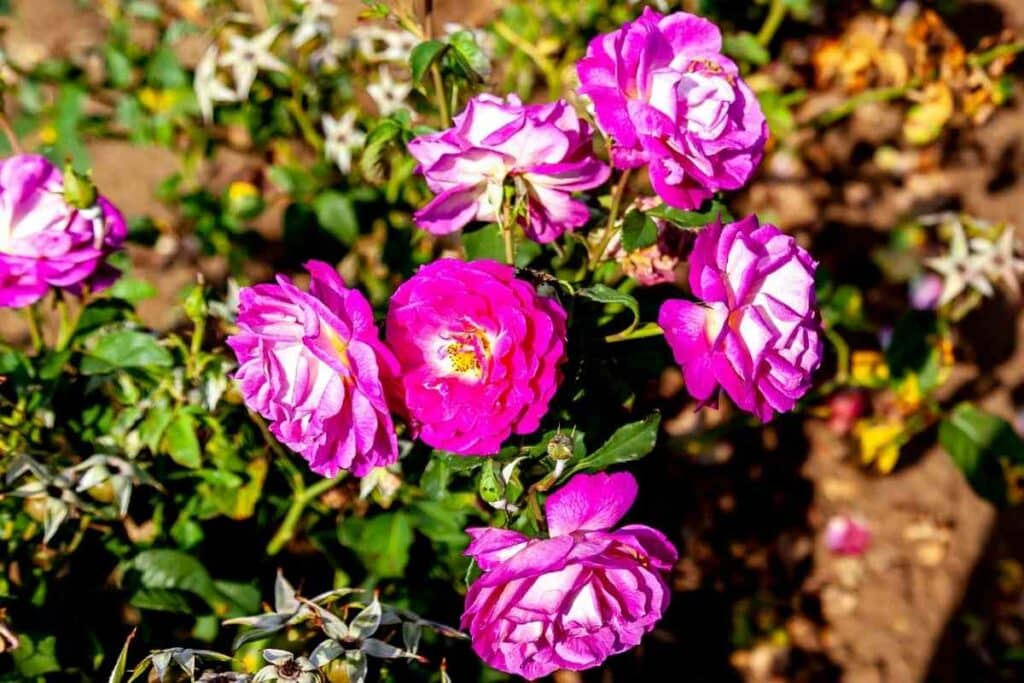
Shrub roses do not have all the drama of a classic tea rose, but they can still put on a good show with beautiful pops of color all over these hardy shrubs.
Modern shrub rose varieties such as the Desdemona English shrub rose or the fragrant William and Catherine bloom twice or more during their growing season, with some blooming continually between late spring and the first frost.
Hybrid tea roses
These beautiful modern rose varieties result from cross-breeding tea roses with hybrid perpetual roses.
They repeatedly flower, up to three times a year, with gorgeous tea roses on long stems that are perfect for cutting.
These roses bloom in the summer, with flushes continuing well into fall.
Climbing roses
Climbing roses are some of the best varieties for repeat flowering.
Bourbon roses are fragrant with long-lasting blooms.
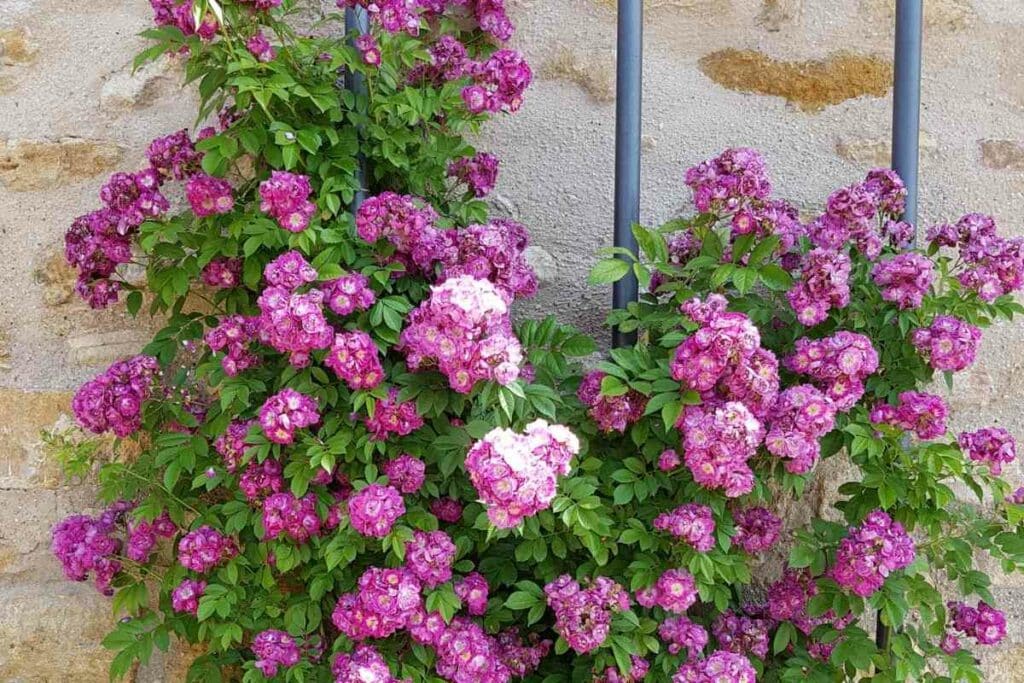
After a summer start, these plucky roses will keep flowering straight through to the fall.
They are also easy to take care of as they don’t need continual pruning, but a late summer deadheading can maintain their blooms in fall.
Floribunda roses
Floribunda roses are a cross between tea roses and polyantha roses that produce large flower heads in delightful clusters.
These contemporary varieties are also repeat flowerers that will return again and again with deadheading.
Even Better – Their maintenance is easy and you should enjoy several blooms if you prune them back in the winter, liberally feed twice per year and keep up with dead-heading once they bloom.
Grandiflora roses
Grandiflora roses are a modern cross of hybrid tea roses and floribunda roses.
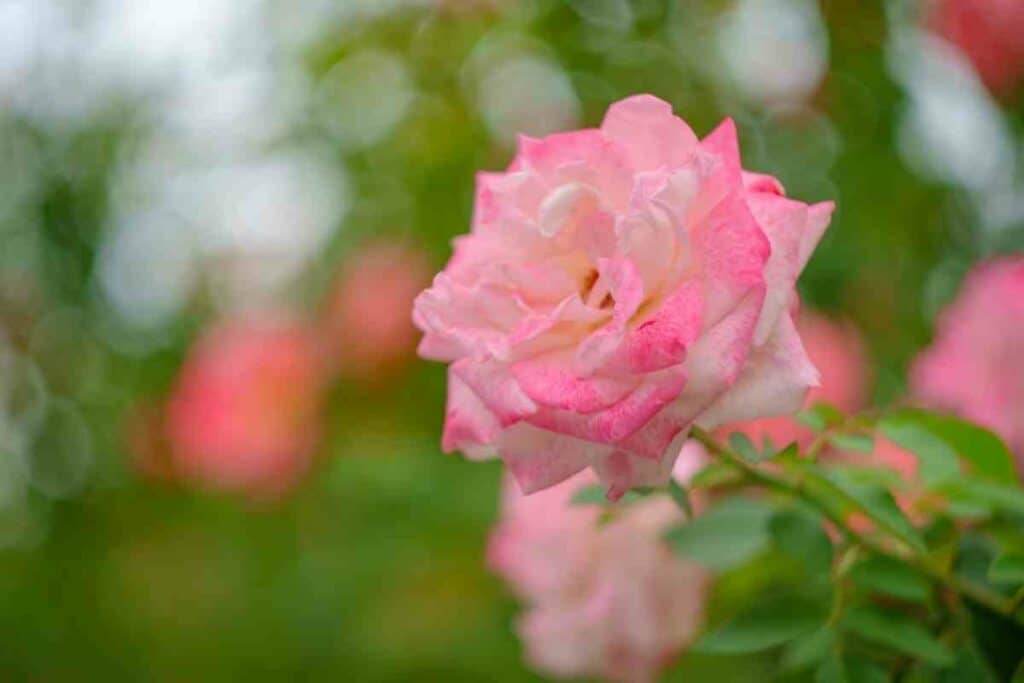
These stately roses are large and elegant with long stems made for cutting.
Grandiflora roses are excellent repeat flowerers and with decent sunshine and a rich geed they will yield repeat blooms of gorgeous clusters.
Re-blooming takes place on a 5-to-7-week cycle. You can stimulate the next blooming cycle by “dead heading”, removing dead or dying flower heads.
Dead-head roses to prolong blooming
Removing spent blooms is one of the best ways to prolong the flowering of your roses.
To do this effectively, remove the flower and stem to the level of the first 5-leaflet, or just above the node where you want a new stem to grow.
Cutting roses indoors while they are at their best can also keep blooms going. By cutting yourself some roses, you are effectively pruning your rosebush.
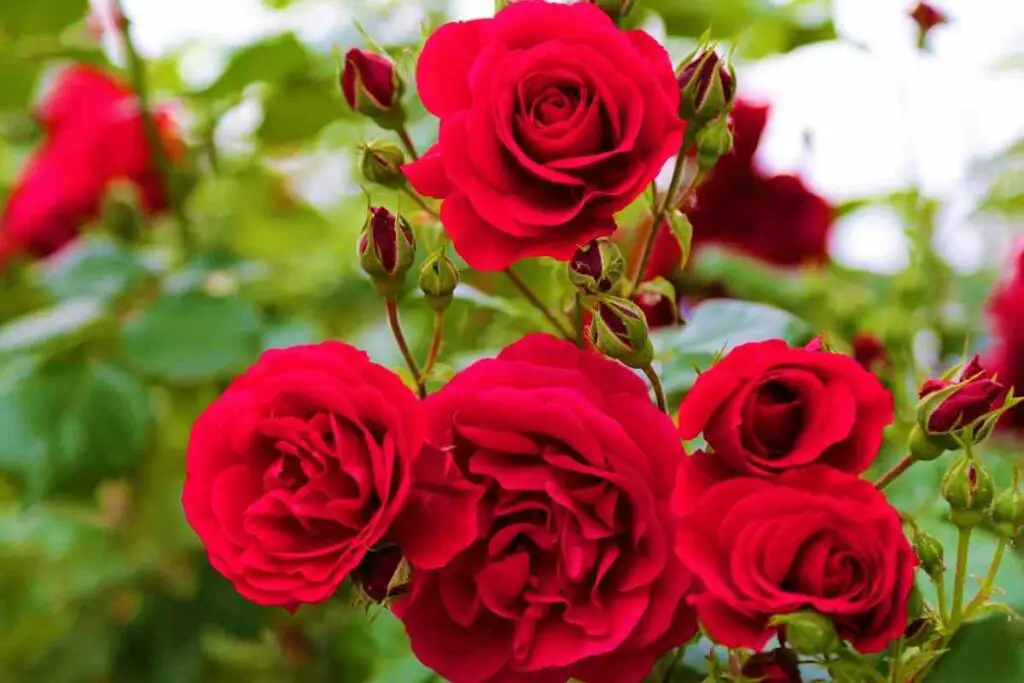
Take care to cut correctly, to preserve the node for new growth, and take long stem roses so that the plant says tidy and compact.
Support your re-blooming roses with the feeding and watering needed to meet their increased demands.
Keep the soil moist and use mulches to help the soil retain moisture. Feed monthly with rich fertilizer throughout the blooming season.
Rounding up
A beautiful rose bush is a sight for sore eyes and can make itself at home in just about any garden.
Give yourself a head start by choosing re-blooming rose varieties that are well-suited to your state.
If you lavish your roses with plenty of TLC, there is no reason you shouldn’t enjoy months of fragrant blooms.
